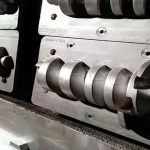I believe that our friends in the mold and Materials Academy are not unfamiliar with 3D printing technology, because everyone will learn about 3D printing in various media every day. Do you know about laser cladding technology? What are the applications of laser cladding technology? What aspects of laser cladding technology can be applied in the mold industry?
What is laser cladding technology?
Laser cladding technology is a new surface modification technology that emerged with the development of high-power lasers in the 1970s. Laser cladding technology was proposed in the 1960s, and the first patent on high-energy laser cladding was born in 1976. In the 1980s, the rapid development of laser cladding technology, combined with the rapid prototyping technology (3D printing technology) that emerged from CAD technology, added new vitality to the laser cladding technology.
Application of laser cladding technology
The application of laser cladding technology is mainly in corrosion resistance (including high temperature corrosion resistance) and wear resistance. The application range is very wide, for example, the sealing surface of the valve and valve seat of internal combustion engine, and the laser melting of water, gas or steam separator Cover, mold surface repair, etc.
Laser cladding technology is applied to the surface treatment of the mold, which can greatly improve the mechanical properties such as the wear resistance of the mold surface and the service life of the material. It not only repairs the mold, but also saves a lot of processing costs.
The advantages of laser cladding technology
- (1) The cooling rate is fast (up to 106K/s), which is a rapid solidification process, and it is easy to obtain a fine-grained structure or produce new phases that cannot be obtained in an equilibrium state, such as unstable phases, amorphous phases, etc.;
- (2) The coating dilution rate is low (generally less than 5%), and it has a strong metallurgical bond or interface diffusion bond with the substrate. By adjusting the laser process parameters, a good coating with low dilution rate can be obtained, and the coating composition and composition Controllable dilution;
- (3) Heat input and distortion are small, especially when high power density fast cladding is used, the deformation can be reduced to the assembly tolerance of the part;
- (4) There are almost no restrictions on the choice of powder, especially for depositing high melting point alloys on the surface of low melting point metals;
- (5) The thickness of the cladding layer is wide, and the thickness of a single-pass powder feeding is 0.2-2.0mm;
- (6) It can carry out selective area welding, with low material consumption and excellent cost performance;
- (7) Beam aiming can weld hard-to-reach areas;
- (8) The process is easy to automate and is very suitable for the wear repair of common wearing parts.
do you know?
The similarities and differences between laser cladding and laser alloying
Laser cladding and laser alloying are both rapid fusion processes produced by a high-energy density laser beam to form alloy coatings with completely different compositions and properties that are fused with each other on the substrate surface. The two processes are similar, but there are essential differences. The main differences are as follows:
- (1) The coating material in the laser cladding process is completely melted, and the base melting layer is extremely thin, so it has minimal effect on the composition of the cladding layer, while laser alloying is to add alloy to the surface of the base material. Element, the purpose is to form a new alloy layer based on the substrate.
- (2) Laser cladding does not essentially use the molten metal on the surface of the substrate as a solvent, but melts separately configured alloy powder to make it the subject alloy of the cladding layer. At the same time, a thin layer of the substrate alloy is melted and formed Metallurgical bonding.
The preparation of new materials by laser cladding technology is an important basis for the repair and remanufacturing of failed parts under extreme conditions, and the direct manufacturing of metal parts. It is highly valued by scientific communities and enterprises around the world.
Link to this article:[3D printing] What are the applications of laser cladding technology?
Reprint Statement: If there are no special instructions, all articles on this site are original. Please indicate the source for reprinting:Mold Wiki,Thanks!^^

